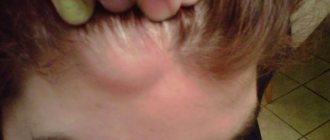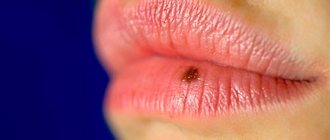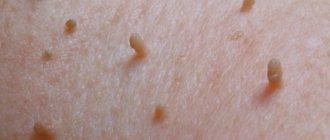Why do papillomas appear?
The basis of any disease is the penetration of foreign pathogenic microorganisms into the body. Papillomas in the mouth, and on other parts of the body, are caused by damage to the body by the human papillomavirus (HPV).
The papillomavirus enters the body from the outside, and you can catch it when:
- Contact with a sick person (kissing, touching the body).
- Use of personal hygiene products for the patient.
- Using household items on which the virus has settled.
Papillomas in the mouth do not appear immediately after the virus enters the body, but only after the onset of favorable conditions conducive to the activation of the virus.
These conditions include:
- Decreased immunity.
- Deficiency of microorganisms, minerals and vitamins in the body.
- Severe stress.
In children, papillomas appear on the tongue because they like to taste all objects affected by the virus, and their immunity is in limbo, and therefore they are more likely to detect growths in the mouth at the time of weakening.
Pregnant women are also at risk for developing tongue papillomas, since the expectant mother’s body is very weakened and growths in the mouth appear in greater numbers and more often.
Papillomatosis according to ICD 10 (international classification of diseases) is assigned code B97.7. This disease must be treated, and the immune system must be maintained, otherwise papillomatosis can lead to serious negative consequences.
Photos of papillomas on different parts of the body
Papillomas on the tongue Under the tongue in the form of shoots There is a large scattering of papillomas on the body. But they appear especially often on the neck. Often papillomas appear right in front of the eyelashes. Sometimes there are several of them on the eye. The mucous membrane is a favorite place for papillomas. Therefore, they are most often found on the lip. HPV is also not uncommon on the penis. This is what an old papilloma looks like on the body. But if the immune system is weakened, papillomas grow in abundance in one place. They can also take on bizarre shapes and colors, but they are all caused by the human papillomavirus
Localization in the mouth
Any growth appears where the mucous area is most susceptible to injury.
The oral cavity is no exception, and papillomas most often appear:
- On the side of the tongue on both sides.
- Below the tongue.
- On the inside of the cheeks.
- At the root of the tongue at the base.
Slightly less often, papillomas can be seen at the tip of the tongue and near the tonsils, papillae, that is, the center of the tongue, are affected even less often.
When shoots appear under the tongue, you should not try to cauterize or cut them off yourself, since warts can, if injured, begin to turn into malignant neoplasms and in the end the patient will receive not only a virus, but also cancer cells.
Localization of papillomas on the tongue is the most inconvenient and dangerous. The growth on the tongue can easily be injured when chewing food, talking, and prevents a person from pronouncing words normally. With multiple lesions of the oral cavity by warts, it is even possible to completely block the breathing lumen if they are large and hang inside the throat, that is, hanging from the root of the tongue or attached to the back of the upper palate closer to the uvula.
Traditional treatment
You can treat papilloma under the tongue using folk remedies. These include:
- Castor oil. It contains antiviral substances that regenerate cells. This method is suitable for rubbing under the tongue. Do this procedure constantly.
- Egg. You can get rid of papilloma by using protein. You need to treat all areas of the mucosa. It is important.
- Celandine. Celandine juice helps get rid of many diseases. Be careful when using celandine. Try not to get it on your skin.
- Infusion of medicinal herbs. To strengthen your immune system, try different herbs. These are nettle, plantain and dandelion. Grind all components. Then mix well. Pour the resulting mass with water and boil over low heat. If it has brewed well, then you can consume it.
- Garlic. In the category of folk remedies, garlic occupies the main place. The plus is that it helps to cope with growths. It can be used as an ointment and to remove papillomas.
- Dandelion. You can get rid of various pathologies with the help of dandelion. Try making an infusion from it. Place dandelion leaves in a glass container. Then pour in triple cologne. This product is useful for lubricating papilloma.
Characteristics of papillomas
Oral papillomas are small (0.5-2 cm) formations that are white or light pink in color. As the disease worsens, the color of the warts in the mouth may begin to change dramatically, turning dark red or even brown.
A wart in the mouth looks different:
- The growth has grown in the form of a drop and is attached to the mucous membrane on a stalk.
- The wart has a flat appearance and only protrudes slightly above the surface of the skin and has clear contours.
Warts often have the same color as the skin surrounding them, that is, if the inside of the cheek is white, then the warts on it will be white, and if the papilloma is on the root of the tongue, then the process will be red or pink.
The type of wart depends on the type of human papillomavirus infection that has affected the human body. Papillomatosis is caused in humans by virus strains No. 1, 2, 3, 16, 18.
Photos of different papillomas
Types and manifestations of pathology
How to treat papillomas on the tongue depends on many circumstances. Affects the choice of methods and the type of tumor formed. Papilloma on the tongue can be of two types:
- Flat. This type of neoplasia rises very slightly above the surface of the skin. It is characterized by fairly large sizes and light color. Usually such a growth is single.
- Thread-like. Its size is somewhat smaller than that of the previous type of papillomas, however, they grow in height. Their color is almost the same as that of the mucous membrane of the tongue. Most often, thread-like formations appear in groups.
There is also a classification of growths according to their location. They can be located under the tongue or on its surface, on the palate, the inside of the cheek, etc. These features also influence the choice of treatment methods, since the further the neoplasia is located on the tongue, the more difficult it is to remove it.
Papillitis of the tongue, unlike other varieties of this disease, is often manifested by severe painful sensations. The pain increases significantly during eating, when food particles touch the papilloma that has formed on the tongue. In addition, other unpleasant symptoms are observed, which depend on where the tumor is located.
Most often, patients who have a pathology such as papillomatosis name the following unpleasant symptoms that occur to them:
- hard breath;
- difficulty swallowing;
- nausea;
- sensation of a foreign object in the mouth.
These unpleasant sensations cause anxiety in patients, so it is very important to answer the question of which doctor to go to with this problem. It is best to visit a therapist and ask him which doctor to see. Pathologies of the oral cavity are dealt with by a periodontist or dentist, respectively, and for papillomas on the tongue, treatment is carried out by this specialist.
In addition, such growths can spread to the respiratory tract, for example, to the walls of the larynx, which can cause serious breathing problems. The likelihood of papilloma on the tongue degenerating into a malignant tumor is very low, but it cannot be ruled out, so high-quality treatment of the disease is necessary.
How to diagnose papillomatosis?
Pathological formations that appear on the tongue cause anxiety in a person, and the first thing he tries to do is find out what it could be. Papillomas are quite easy to diagnose even by sight. They come in two types and look different. Symptoms other than the presence and appearance of a wart are not needed to diagnose the disease.
| Type of papilloma | Characteristic |
| Pointed papillomas | They are pinkish in color and look like papillae. The stalk on which they are attached to the tongue can be very large, which increases the likelihood of injury and even complete tearing off of the wart. This new growth resembles cauliflower in appearance. |
| Flat papillomas | Flat elements that slightly rise above the level of the mucosa and are very different in color from the surrounding tissues. Often they exist for a long time without treatment, since they do not cause discomfort or pain to a person. |
A characteristic feature of papillomas is the appearance of bleeding ulcerations at the site of the torn wart. Such injuries negatively affect the wart cells and over time they can begin to degenerate into cancerous ones.
There are two types of oral papillomatosis:
- Reactive - warts arise due to constant and frequent exposure to irritants (thermal, viral, chemical or mechanical irritation of the mucous membrane).
- Neoplastic - warts are present in large numbers in the form of nodular neoplasms, can be collected in groups, or are located throughout the oral cavity.
Neoplastic papillomatosis of the oral cavity is quite rare. More often, single genital warts can be seen on the tongue.
Features of the pathology
The resulting cavity filled with blood is a hematoma, due to which a small blood clot accumulates in the bladder and occurs due to damage to blood vessels.
We suggest you read What to do if your jaw crunches and clicks when chewing and opening your mouth: the most common causes, treatment at home and surgically
The factors that caused the injuries are divided according to their impact, namely:
- Mechanical impact. In such a situation, injuries may be caused by a foreign object. For example, a spoon, a toothpick, or the products themselves, for example, fish bones or seed shells. The most common cause of a blood blister is considered to be banal biting while eating, which is why the surface may remain intact, but the vessels inside will burst;
- Chemical exposure. It occurs due to too many spices. If food is very spicy or salty, it irritates the mucous membrane. In addition, a chemical burn can occur after taking medications or accidentally ingesting chemicals in the mouth while cleaning dishes, mopping floors, etc.;
- Thermal impact. Any food that is too cold or hot that gets into the mouth causes irritation, such as hot coffee or ice water.
You can understand how great the degree of injury is by looking at the fluid in the cavity.
When it is serous, it has a light tint and it follows that the vessels are intact and the damage is superficial. This type of injury goes away faster than if there is a blood clot inside, which is an excellent place for germs to multiply.
In addition to color, the place where the injury is localized can help in treatment and diagnosis, namely:
- A bubble located under the tongue;
- On the upper surface of the tongue;
- On the lateral surface of the tongue.
When there are a lot of bubbles, and they are located both on the tongue and under it, this can be a consequence of many pathologies, for example, stomach diseases or as a symptom of stomatitis, as well as endocrine disorders. If there is only one cavity, it is often a hematoma or ranula.
Which doctor should I contact?
To diagnose the disease, you must first consult a therapist. It is he who will examine the person and establish a presumptive diagnosis, after which he will issue a referral to an infectious disease specialist (this is a viral disease) and a dermatologist (although this is not skin, even the examination of a piece of tissue will be carried out using the same methods as the examination of the skin).
The dentist plays an important role in establishing the diagnosis - he is the first to notice neoplasms during a routine examination. Therefore, you should not neglect visits to him.
How to identify the disease
If one or more symptoms are detected, it is recommended to consult the following doctors.
The dentist will help identify the presence of diseases of the teeth, gums, etc. Often, precisely because of the neglected condition of the teeth or the presence of inflammation, a person develops growths on the mucous membranes.
The next specialist is an ENT specialist. It is necessary to contact him in order to prevent the growth of formations in the larynx and nasopharynx. Special equipment and the doctor’s experience will help identify the disease at an early stage and prevent infection of other areas.
A gynecologist, a venereologist and a urologist are the doctors who must be visited if you have condylomas in the mouth, because they have the same appearance as warts on the genitals.
Treatment of tumors on the tongue
Treating papillomas on the tongue is not easy. You can't get away with pills alone. For recovery and disappearance of warts from the oral cavity, the patient will need to undergo comprehensive treatment.
Main stages of treatment:
- Drug therapy.
- Surgical removal of warts.
- Ethnoscience.
Removing papillomas surgically without drug treatment will not give a 100% result. Drug therapy can help remove even large warts without having to cut them out.
But folk remedies can only be used with the permission of a doctor and in addition to the main therapy, and not to replace it.
Drug therapy
Treatment with medications is aimed at eliminating and deactivating the human papillomavirus. Doctors often prescribe immunostimulating drugs, as well as antiviral drugs (Panavir). An oil solution of vitamin A has proven itself well; it is recommended to lubricate papillomas on the tongue every day.
Photo
Not all anti-virus drugs are approved for pregnant women, as many of them negatively affect the development of the fetus. Viferon, Kipferon, Reaferon - these are the drugs most often recommended for pregnant women. But you cannot prescribe them for yourself; this can only be done by a doctor, having assessed the risk to the baby’s health.
Surgical removal of warts
If warts are very bothersome to the patient or drug treatment is not enough to completely disappear them, they can be removed.
To do this, use the following methods:
- Cryodestruction - cauterization with cold liquid nitrogen.
- Removal by electric current.
- Radio wave surgery.
- Conventional excision with a scalpel.
- Laser removal.
All methods are approximately the same, only in some there is a longer rehabilitation period, in others there is a high price, in the third there is a likelihood of relapse of the disease. The patient must choose the excision method together with the doctor so that he can assess its feasibility and necessity.
Video: laser removal
ethnoscience
Traditional medicine does not help in removing warts from the tongue. These are rather preventive and hygienic procedures for sanitation of the oral cavity. Potato juice helps a lot if you drink it every day. Also, rinsing your mouth with a mixture of horsetail, nettle, plantain and lemon balm helps get rid of bacteria and boost local immunity in the mouth. Rosehip and echinacea tincture will restore immunity from the inside so that the body can quickly cope with the virus.
Is it possible to treat papillomas using traditional methods?
Non-traditional methods for treating growths on the tongue show low effectiveness due to the peculiarity of the localization of papillomas. It is better not to waste time on alternative treatment, but to immediately contact a specialist and remove the growth.
Nevertheless, folk methods have quite a lot of adherents who speak positively about the treatment of papillomas in the mouth using the following means.
- Grate a few pink potatoes. For treatment, only raw, unpeeled potatoes are used, since the skin contains a lot of useful substances. The resulting mass must be filtered, collecting the juice in a container. The juice is then used for the first 10 minutes to rinse the mouth. If it has darkened, this means an oxidative reaction, as a result of which the juice loses its medicinal properties.
- Another potato recipe is to infuse the skins of pink potatoes with vodka and use them to rinse the mouth, after diluting them with water in equal proportions.
- To treat papillomas, it is recommended to drink half a glass of cranberry juice daily, as it stimulates the immune system to fight the virus.
It is recommended to use folk remedies in conjunction with drug treatment. Children should follow the doctor's recommendations, but not try to treat themselves.
There is no specific prevention for HPV, since the virus can be contracted under any conditions. Children, mainly girls, are now offered vaccinations against dangerous oncogenic strains of the virus. This provides protection against the types of HPV that cause cervical cancer, but does not protect against simpler strains of the virus.
Optimal prevention is maintaining your own immunity and timely treatment of any diseases, including common colds. It is important to remember: the virus is activated only against the background of a decrease in immune defense.
Prevention of human papillomavirus infection
To prevent the virus from entering the body, certain rules should be followed:
- Maintain personal hygiene
- Maintain hygiene of clothing and household items.
- Use only personal body and hair care items.
- Get vaccinated against HPV as early as possible.
If infection with the virus has already occurred, then you should pay attention to your immunity:
- Take vitamin complexes.
- Eat right (the diet should be complete in terms of protein, fat, carbohydrates and vitamins).
- Do not overcool or overheat.
- Do not be exposed to harmful factors (various types of radiation and even visiting a sauna - overheating).
- Treat all diseases at the initial stage to prevent an even greater decline in immunity.
By following these rules, you can protect yourself for a long time from the effects and manifestations of human papillomavirus infection. If warts have already begun to appear on the tongue, you should consult a doctor for help in treatment.
Video
Removal of condylomas
Since most external agents, such as ointments, are not suitable for use on the tongue, antiviral and immunomodulatory therapy is combined with surgery. To accurately get rid of the manifestations of HPV, papillomas are removed. Previously, this was only done by excision with a scalpel, but today there are other methods.
One of the most popular is laser removal. The procedure is carried out very quickly, it is relatively painless and does not lead to blood loss. Typically, condyloma medius can be removed in just one session, which will last about fifteen minutes. The vessels that fed the growth will be cauterized with a laser. It will no longer receive nutrients, and therefore will soon die.
Important!
The absence of bleeding prevents the possibility of changing the location of formations.
A common method is cryodestruction, which involves treating growths with liquid nitrogen. However, it is used very rarely in the tongue area, since the mucous membranes of the oral cavity are difficult to tolerate such exposure. This technique is not at all suitable for children. Sometimes patients are referred to cauterize formations with electric current, or this is done using radio waves.
After all papillomas from the tongue are removed, the patient will need to carefully monitor his health. If he maintains a strong immune system and avoids promiscuity, he will most likely protect himself from relapses of the disease.
Reviews
Camilla, Eagle I once had a small wart on my tongue. It didn’t interfere much, but there was some discomfort. I anointed it with vitamin A, after a month it was all gone.
Vitaly, Perm The papilloma on my tongue was decent. I decided to undergo laser removal (I took pills along the way). Anyone who has had laser removal knows that it doesn’t hurt. I liked the effect, everything went quickly and so far the papilloma has not returned.
Elena, Vladivostok A couple of years ago I got a wart on my tongue and two more on my right cheek. The doctor prescribed several types of tablets and ointment. But the papilloma on the tongue was still removed with a laser, since it decreased in size, but did not disappear.
Therefore, after surgical removal of papillomas from the surface of the tongue, you should:
- Take precautions and limit risk factors (see above).
- Take a course of antiviral treatment as recommended by your doctor.
- Seasonally take immunomodulatory drugs and vitamin complexes, which your doctor will also help you choose.
- Maintain oral hygiene and avoid tongue injuries.
One of the main conditions for achieving a favorable outcome in the fight against papillomas is choosing the right medical center, since much in the procedure for removing a tumor depends on the actions of the doctor. We hope that the recommendations of specialists from the LeaderStom network of dental clinics helped you clarify the picture of the growth that has developed on your tongue, and now you can solve this problem without unnecessary emotional distress.











